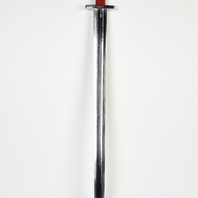
Viking Objects
Reproduction Viking Age Sword
A reproduction of the sword found in Grave 511 at Repton. The hilt is made of wood laths wrapped in tabby weave textile strips. The scabbard is made of two wooden laths, lined with trimmed sheep fleece, and covered in an oak-stained, stitched, calf-leather cover. The strap slide is copper alloy and inserted under the leather. The sword belt shown with the scabbard is based on the sword belt from Grave 511 at Repton.
Read More
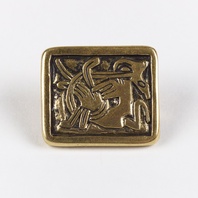
Viking Objects
Reproduction Square Mammen Brooch
This reproduction brooch is based on a small number of Mammen-style brooches found in England. Three rectangular brooches of this type are known from Linwood, Lincolnshire, West Stow Heath, Suffolk, and Bergh Apton, Norfolk, with further examples found in Cambridgeshire and East Anglia in 2015 and 2016. It is a type which has Carolingian-inspired shapes and Scandinavian decoration, which seem to have been produced in the Danelaw, and was an accessory for women who wore Scandinavian dress. Scandinavian brooches came in a variety of sizes and shapes which included disc, trefoil, lozenge, equal-armed, and oval shapes. The different brooch types served a variety of functions in Scandinavian female dress with oval brooches typically being used as shoulder clasps for apron-type dresses and the rest being used to secure an outer garment to an inner shift. Anglo-Saxon brooches do not match this diversity of form with large disc brooches being typical of ninth century dress styles with smaller ones becoming more popular in the later ninth and tenth centuries. However, since disc brooches were used by both Anglo-Saxon and Scandinavian women they are distinguished by their morphology. Scandinavian brooches were typically domed with a hollow back while Anglo-Saxon brooches were usually flat. Moreover, Anglo-Saxon brooches were worn singly without accompanying accessories.
Read More
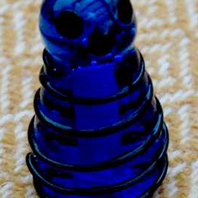
Viking Objects
Reproduction Glass Kingpiece
This glass kingpiece is a reproduction based on a set found in grave 750 at the Viking Age settlement of Birka, Sweden. This piece would have been used to play hnefatafl, a board game which is known to have been played in Scandinavia in the Viking Age.
Read More
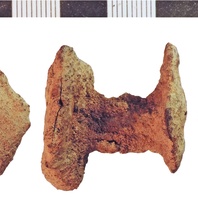
Viking Objects
Clench Nail (NLM-2FC690)
Clench nails were used in clinker-style ship-building from the 7th century to the 15th and also for domestic purposes, in which clench nails might appear where ship timber has been reused. Clinker ship-building involved building the ship’s hull first out of layered planks attached to the keel and held together using clench nails. Clinker-built boats and ships are particularly associated with the Vikings.
Read More
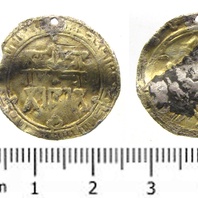
Viking Objects
Samanid Silver Dirham Pendant (LCNCC:2014.16)
An Arabic silver dirham minted c. 905-906 (Hijra 293) for the Samanid ruler, Isma’il ibn Ahmad (849-907), that has subsequently been pierced and gilded so that it could be worn as a pendant. It was probably minted in Balkh, Afghanistan. The Vikings often repurposed items like this. The dirham was a unit of weight used across North Africa, the Middle East, and Persia, with varying values which also referred to the type of coins used in the Middle East during the Viking Age. These coins were extremely prized possessions not only for their silver value but as a way of displaying one’s wealth and vast trade connections. Millions of Arabic dirhams would have been imported throughout the Viking world and are mostly found in hoards.
Read More
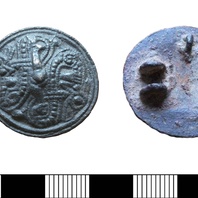
Viking Objects
Jellinge-Style Disc Brooch (LIN-F00E1B)
This Viking cast copper-alloy disc brooch is decorated with a Jellinge-style moulded zoomorphic motif comprising a knot of beaded lines. Brooches of this type are widespread in Scandinavia, with a particular concentration at Birka, the trading and military site in Sweden. For more information on Scandinavian jewellery in England check out our blog: Brooches, Pendants and Pins: Scandinavian Dress Accessories in England.
Read More
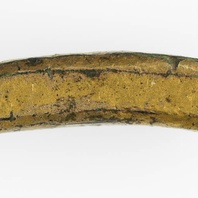
Viking Objects
Forged Hack-gold Rod (CM 595-2010)
This forged hack-gold rod comprises a curved section of gilt copper-alloy. It is square in cross-section and is broken at both ends. It shows that someone near Torksey was trying to con others by passing copper-alloy as gold. Like hacksilver, hack-gold was used to pay for items by weight of precious metal. The buyer and seller would agree the value of an item and pieces of silver or gold would have been cut up and weight out until the right amount had been paid. Gold was much less common among the Vikings than silver.
Read More
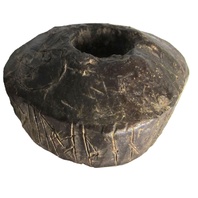
Viking Objects
Saltfleetby Spindle Whorl (LIN-D92A22)
A lead spindle whorl found at Saltfleetby St Clement, Lincolnshire, and inscribed with runes. The dating of the spindle whorl is uncertain, and dates in the late Viking Age, the early eleventh century, or even the twelfth century, have been suggested. The spindle whorl is inscribed with Scandinavian runes that appear to mention the Norse gods Odin and (possibly) Heimdall. The object is likely to have been produced locally, though the runes demonstrate contacts with the Scandinavian world of the time, perhaps especially Norway. John Hines has suggested the translation ‘Óðinn and Heimdallr and Þalfa, they are helping you, Úlfljót, and …’. For further discussion of the text, see the open-access article by Jesch referenced below. For more on runes, see our Runes page.
Read More
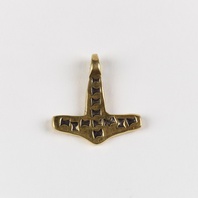
Viking Objects
Reproduction Hammer-shaped Pendant
A gold hammer-shaped pendant, popularly called a Thor’s hammer pendant, from Spilsby, Lincolnshire. These may have been worn to show devotion to the god Thor, or to secure the god’s protection, although there is little evidence to support this interpretation. Pendants like this have been found made of lead, copper alloy, silver and gold, showing that many different strata of society could have worn them.
Read More
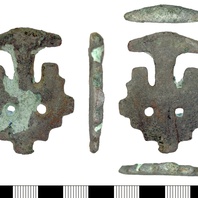
Viking Objects
Copper-Alloy Die Stamp (DENO-698D71)
A copper-alloy die, known as Hiddensee-Rügen type, used for making pressed silver or gold sheet appliqués, which were applied to the back-plate of pendants or used as a base for filigree and granulation work.
Read More
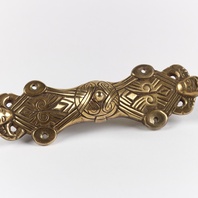
Viking Objects
Reproduction Equal-Armed Brooch
A reproduction of an equal-armed brooch in the Borre style found in Nottinghamshire. This style of brooch is known from Birka in Sweden, suggesting trade contacts or individuals from Birka arriving in the East Midlands. Brooches were a typical part of female dress. Scandinavian brooches came in a variety of sizes and shapes which included disc, trefoil, lozenge, equal-armed, and oval shapes. The different brooch types served a variety of functions in Scandinavian female dress with oval brooches typically being used as shoulder clasps for apron-type dresses and the rest being used to secure an outer garment to an inner shift. Anglo-Saxon brooches do not match this diversity of form with large disc brooches being typical of ninth century dress styles with smaller ones becoming more popular in the later ninth and tenth centuries. However, since disc brooches were used by both Anglo-Saxon and Scandinavian women they are distinguished by their morphology. Scandinavian brooches were typically domed with a hollow back while Anglo-Saxon brooches were usually flat. Moreover, Anglo-Saxon brooches were worn singly without accompanying accessories.
